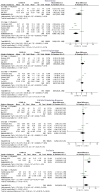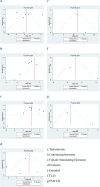The Effect of COVID-19 on Male Sex Hormones: A Meta-Analysis of Prospective Cohort Study
- PMID: 38407718
- PMCID: PMC11176140
- DOI: 10.1007/s44197-024-00203-x
The Effect of COVID-19 on Male Sex Hormones: A Meta-Analysis of Prospective Cohort Study
Abstract
Purpose: To evaluate the possible effects of novel coronavirus disease 2019 (2019-NCOV) on male sex hormones and reproductive ability, and analyze its incidence and risk factors.
Methods: We retrieved from PubMed, Embase, The Cochrane Library, Web of Science, Clinical Trails, CNKI, CBM, Wan Fang Database and VIP to collect research on the effects of COVID-19 on the male sex hormone. Our literature search was conducted until April 2022, and two investigators independently screened articles based on inclusion and exclusion criteria. In strict accordance with the inclusion and exclusion criteria, two researchers independently screened the literature and comprehensively analyzed 8 cohort studies on the impact of COVID-19 on male sex hormone. And We used RevMan5.4.1 and Stata15.0 for statistical analysis. Finally, there were eight cohort studies on the effects of COVID-19 on male sex hormones.
Results: T(RR = - 3.94; 95% CI - 6.22, - 1.66; P = 0.0007), testosterone in the COVID-19 group decreased by 3.94 nmol/L compared with the control group, and the difference was statistically significant. LH (RR = 0.85; 95% CI - 0.26, 1.96; P = 0.13), the LH in COVID-19 group was 0.85 mlU/ml higher than that in control group, but the difference was not statistically significant. FSH (RR = 0.25; 95% CI - 0.72, 1.23; P = 0.61), the FSH of COVID-19 group was 0.25 mlU/ml higher than that of the control group, but the difference was not statistically significant. PRL (RR = 2.42; 95% CI 0.52, 4.31; P = 0.01), the PRL in the COVID-19 group was 2.42 ng/ml higher than that in the control group, and the difference was statistically significant. E2(RR = 11.88; 95% CI 9.90, 13.86; P < 0.00001), The level of E2 in the COVID-19 group was 11.88 pg/ml higher than that in the control group, and the difference was statistically significant. T:LH (RR = - 0.39; 95% CI - 076, - 0.02; P = 0.04), the ratio of T:LH in COVID-19 group was lower than that in control group, and the difference was statistically significant. FSH:LH (RR = - 0.38; 95% CI - 0.86, 0.11; P = 0.13), the ratio of FSH:LH decreased in COVID-19 group compared with control group, but the difference was not statistically significant.
Conclusions: COVID-19 can affect the level of sex hormones, especially T, which may further affect male fertility. Due to the limitations of this study, this conclusion needs to be further verified by large-sample, high-quality prospective cohort studies on the long-term effects of COVID-19 on male sex hormones and fertility.
Keywords: COVID-19; Luteinizing hormone; Male fertility; Sex hormone; Testosterone.
© 2024. The Author(s).
Conflict of interest statement
The authors have no competing interests to declare that are relevant to the content of this article.
Figures





Similar articles
-
Associations between COVID-19 infection and sex steroid hormones.Front Endocrinol (Lausanne). 2022 Oct 11;13:940675. doi: 10.3389/fendo.2022.940675. eCollection 2022. Front Endocrinol (Lausanne). 2022. PMID: 36303865 Free PMC article.
-
An examination of blood steroid and gonadotropin concentrations in relation to fertility status and testicular function in men.Fertil Steril. 1982 Oct;38(4):465-70. doi: 10.1016/s0015-0282(16)46582-9. Fertil Steril. 1982. PMID: 6811340
-
SARS-CoV-2 Pneumonia Affects Male Reproductive Hormone Levels: A Prospective, Cohort Study.J Sex Med. 2021 Feb;18(2):256-264. doi: 10.1016/j.jsxm.2020.11.007. Epub 2020 Nov 27. J Sex Med. 2021. PMID: 33468445 Free PMC article.
-
A systematic review of the effect of COVID-19 on semen parameters.Heliyon. 2023 Apr;9(4):e14776. doi: 10.1016/j.heliyon.2023.e14776. Epub 2023 Mar 23. Heliyon. 2023. PMID: 37035366 Free PMC article. Review.
-
The Effect of Longer-Acting vs Shorter-Acting Testosterone Therapy on Follicle Stimulating Hormone and Luteinizing Hormone.Sex Med Rev. 2021 Jan;9(1):143-148. doi: 10.1016/j.sxmr.2020.07.006. Epub 2020 Sep 8. Sex Med Rev. 2021. PMID: 32912767 Review.
References
-
- Sun Bang Wu, Xueyan NM. Damage and mechanism of novel coronavirus to male reproduction. Chin J Androl. 2021;27(08):738–741. doi: 10.13263/j.cnki.nja.2021.08.012. - DOI
-
- Xu W, Lixiang Z, Liya A, Yingenzyme Z, Huan-Rui S, Ruo-peng Z. Effects of novel coronavirus disease 2019 (2019-NCOV) on reproductive systems of both sexes. Chin J Eugenics Genetics. 2021;29(06):884–7. doi: 10.13404/j.cnki.cjbhh.20210927.019. - DOI
Publication types
MeSH terms
Substances
Grants and funding
LinkOut - more resources
Full Text Sources
Medical
Miscellaneous

